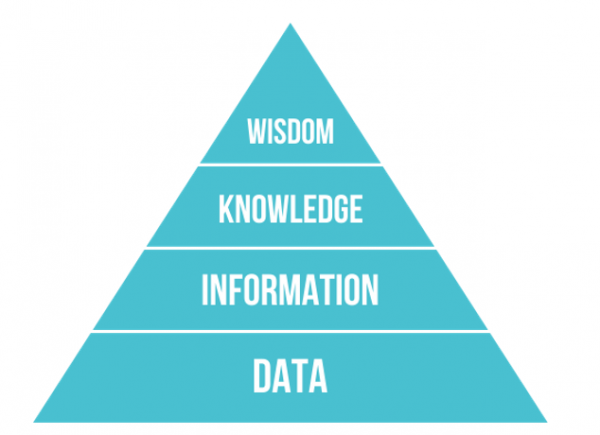Hello and welcome to my blog! If you are a returning reader you know that last time I discussed the difference between Governance and Management and offered my take on what each represents and why Governance needs to be put in place, preferably first, to ensure effective Management. I also “left out” any mention of Data or Information, or any other reference to what is being governed and managed because I thought it helpful to first distinguish the two concepts before applying them to an area of interest.
Aside from that reason, I also have seen confusion and uncertainty at organizations as to what exactly is being governed (or managed) due to often using these terms (Data, Information) interchangeably, resulting in ambiguity and mis-understandings. There really is a difference between Data and Information and this difference directly affects the rules, processes and rights defined by the Governance program. It is for this reason that I believe that, even if the organization as a whole continues to live with this ambiguity, governance practitioners should understand and distinguish between the different concepts in order to ensure the most appropriate governance components get created and applied to the right situation.
Now some would argue that distinguishing between these two is just semantics and does not provide value. I may not be able to dissuade those that feel this way, but I hope this post will at least give some credence to my belief that it really is beneficial to distinguish between the concepts. After all, our language is all we have to communicate, so using the right term to identify a concept, consistently, will increase the effectiveness of your communications and greatly reduce mis-understandings and mis-interpretations – which, for governance, is an essential factor in achieving success.
 So, what is the difference and why should we care? Well, I am not an “information scientist”, but it may surprise you to know that there is extensive thinking on this subject and one of the more popular models used to describe the differences is what is known as the “DIKW Pyramid” where the initials stand for Data, Information, Knowledge and Wisdom respectively.
So, what is the difference and why should we care? Well, I am not an “information scientist”, but it may surprise you to know that there is extensive thinking on this subject and one of the more popular models used to describe the differences is what is known as the “DIKW Pyramid” where the initials stand for Data, Information, Knowledge and Wisdom respectively.
The premise of the pyramid is that each concept builds upon the previous one, with Data as the base and Wisdom as the pinnacle. Now here’s where it gets tricky. The biggest challenge is reaching a common understanding of how to distinguish, or define, each layer. If you do any poking around, you will find that theorists, educators, scientists and even philosophers have struggled with this over the years (some would even say that so much so that the Pyramid has little value – I don’t happen to agree, but I digress.)
Given that I want to distinguish the layers only in a manner that benefits the establishment of a governance program, I am not looking for a universal definition, but simply one that will work for practitioners of governance within the context of business.
So, here are my succinct descriptions of each of the layers:
Data: Facts or unqualified observations
Information: Data in context or inter-related
Knowledge: Application of information to a scenario or situation
Wisdom: Use of the “right” knowledge at the “right time
For example: I may have a phone number, that is a piece of Data; but I also have tagged it as the contact number for an individual, that is Information; further, I know that this person can be reached at that number consistently only during regular business hours, that is knowledge; and finally, from my experience, if I want to get this person to commit to helping me out with a project it is best never to call after lunch, as first thing in the morning is when the individual tends to be most agreeable – that is Wisdom!
This concept can be applied to any scenario you can imagine, and works equally well whether you traverse the pyramid from bottom up (as I did in the example) or top-down (start with a nugget of Wisdom and work down to the Data you need to support it).
Now, you may be saying to yourself, “ok, but so what? How does this help when it comes to Governance?”
Well, it helps in two primary ways.
First, once you have determined which layer you are concerned with, creating the controls, processes and rights become very straightforward and focused upon that aspect – creating the set of rules for a properly represented and current phone number is relatively simple and highly “automatable”, whereas rules for “correct” contact numbers are a little more complex. Regardless, knowing which layer you are defining governance components for helps to maintain the scope of the effort.
Second, and to me the far more valuable reason, is that this allows for targeting the most effective and valuable governance components to be put in place and minimizes wasting time on non-essential items. This is especially true if you work from the top down (some would call this an “outcome-based approach”) For example, knowing that the goal of an enterprise is to move away from the use of pagers (Wisdom telling you that it is a dying technology, based upon the Knowledge that pager use has declined steadily, represented by the Information of so few individuals in your repository have a pager number associated to them), tells you that it is probably a significant waste of time to worry about the quality of the Data that represents pager numbers.
So, by distinguishing between these concepts, and starting with the Wisdom layer, allows Governance Programs to focus their efforts on the most important things first, thereby addressing high-value areas first; and keeps the components that are defined (controls, processes and rights) targeted to the type of item being governed, thereby minimizing waste of time, effort and resources. To my mind, a pretty good return on investment in distinguishing between these concepts.
Finally, the reality is that governance is most often applied to the Data and Information layers, but, even though that may be the focus, recognizing the differences and having Wisdom and Knowledge drive the governance programs, positions the program very well to provide significant business value.
So, now that we are talking again about the establishment of Governance, another area that often causes confusion is whether Governance is a Strategic or Tactical endeavor. Well, as you have probably already deduced, I believe the first step is to understand the difference between Strategy and Tactic. This understanding, along with the understanding of Governance itself and what is being governed (DIKW), will provide insight into where a Governance program fits within an enterprise. This will be the subject of my next post: “Strategy and Tactics – Know your ‘What’ from your ‘How'”.
So, until next time, thanks again for reading my blog!

